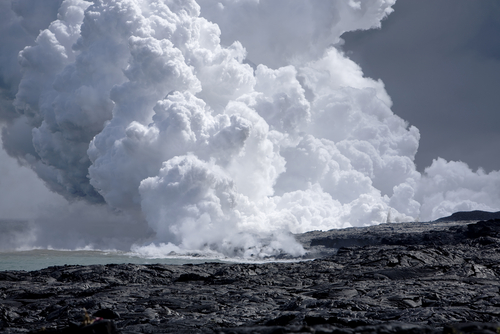People with asthma, especially children, who are exposed to high levels of sulfur dioxide (SO2) in gases released from the active volcano Kīlauea, in Hawai, are at greater risk of having serious attacks, a study reported.
Kilauea Volcano’s ongoing 30-plus-year eruption produces substantial sulfurous air pollution called “vog” in nearby island communities. Exposure to sulfur dioxide and sulfates can increase the risk for asthma attacks, but little is known about asthma epidemiology in regions close to active volcanoes.
To assess if vog exposure was associated with a higher incidence of asthma attacks in exposed residents, nurse epidemiologist Bernadette Mae Longo, from the University of Nevada, conducted a community-based study to estimate the incidence and relative risk (RR) of clinic and emergency department visits for acute exacerbations of asthma (AEA) over a seven-year period, capturing low and high exposure time periods.
“As a nurse, it touched my heart, because I knew as I read a medical record that this was a real person struggling. Or maybe this was a family with a baby or child that had asthma, and it is very frightening when an asthma attack occurs,” said Longo in a news release.
Longo presented the study results at a recent meeting of the Geological Society of America (GSA) in Denver, Colorado. Her presentation was titled, “The overriding question was: ‘is all the volcanic air pollution making people sick?’”
In the study, Longo compared communities living downwind of the volcano, and exposed to SO2 emissions, to communities upwind of the volcano. Longo recorded information from more than 1,000 visits from patients, who ranged in age from 3 months to more than 89 years old.
She found that the incidence of AEA was associated with SO2 levels in the exposed community preceding and during the summit eruption.
After adjusting the data for age and gender, epidemiologic estimates revealed that there was a three-fold elevated risk for AEA in the downwind exposed community, compared to populations living upwind of the volcano.
Asthmatic children living near Kīlauea suffered the highest burden of attacks relative to other age groups. The risk for asthma attacks also increased in accordance with higher SO2 exposure time and geospatial pattern.
Results also showed that communities closer to the vents had a higher risk of asthma attacks compared to communities farther downwind.
At the beginning of the study, the East Rift Zone of Kīlauea was continuously erupting on a small-scale, but in 2008, a new vent and lava lake formed on the volcano’s summit, thereby increasing volcanic gas SO2 emissions and vog in contrast to previous levels. Even now, downwind communities still exceed the Environmental Protection Agency (EPA) recommendations for SO2 exposure a few times during the week.
“It allowed for a natural experiment of low vog exposure and high vog exposure,” said Longo. “We found that there was already significant risk before the summit eruption, but the magnitude of risk increased after the eruption.”
Exposure to vog is hazardous to asthma populations due to the increased risk for acute exacerbation. Repeated exacerbations can lead to asthma progression. Asthmatics living near active volcanoes should follow specific management regimes, Longo suggested.

